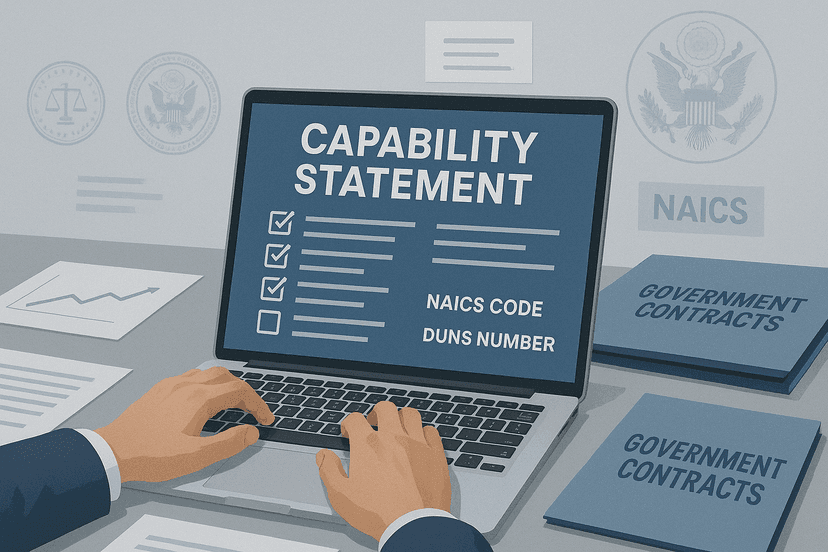Get Your Business Government Contract Ready: 10 Steps to Win Your First Federal Contract

Get Your Business Government Contract Ready: 10 Steps to Win Your First Federal Contract
The U.S. government is the largest single buyer of goods and services in the world, spending over $650 billion on contracts each year. For small businesses, this represents a monumental opportunity for stable, long-term growth. But before you can win your first contract, you need to lay the proper groundwork.
Navigating the world of federal procurement can seem intimidating, filled with unfamiliar acronyms and complex registration processes. The good news? It's a solvable puzzle.
This 10-step checklist will demystify the process and provide a clear roadmap to get your business "government-ready." Follow these steps, and you'll be prepared to confidently find and bid on your first government contract.
Step 1: Establish Your Business as a Legal Entity
Before the government can do business with you, you need to be a formal business. If you're operating as a sole proprietor, it's highly recommended to establish a formal legal structure.
Why it's important: A formal structure (like an LLC, S-Corp, or C-Corp) protects your personal assets from business liabilities and signals to contracting officers that you are a serious, stable enterprise.
How to do it: Register your business with your state's Secretary of State office. Consult with a legal or financial advisor to choose the structure that's right for you.
Step 2: Get Your Federal Tax ID Number (EIN)
An Employer Identification Number (EIN) is a unique nine-digit number assigned by the IRS to identify a business entity. Think of it as a Social Security number for your company.
Why it's important: You will need an EIN for nearly every government registration, including the crucial SAM.gov profile.
How to do it: Applying for an EIN is free and can be done in minutes on the official IRS website.
Step 3: Identify Your Core NAICS Codes
The government uses the North American Industry Classification System (NAICS) to classify businesses by industry. Identifying your primary NAICS codes is one of the most critical steps in this process.
Why it's important: NAICS codes are how the government categorizes its procurement needs. If an agency needs "Custom Computer Programming Services," they will post the opportunity under NAICS code 541511. Having the right codes on your profile ensures you show up in their searches and that you are notified of relevant opportunities.
How to do it: Use the official NAICS search tool on the Census Bureau's website. Look at the codes listed by your successful competitors. Most businesses have one primary code and several secondary codes.
Step 4: Know Your Product Service Codes (PSCs)
While NAICS codes identify your industry, Product Service Codes (PSCs) describe what you actually sell—the specific products, services, or R&D.
Why it's important: PSCs provide a deeper level of detail for contracting officers. An opportunity might have a broad NAICS code but a very specific PSC, making it a key data point for finding perfectly matched contracts.
How to do it: You can browse the PSC Manual to find the codes that best match your offerings.
Step 5: Obtain Your Unique Entity ID (UEI) on SAM.gov
The era of the DUNS number is over. The federal government now uses a Unique Entity ID (UEI) as the official identifier for businesses.
Why it's important: You cannot register in SAM.gov, bid on, or win federal contracts without a UEI. It is the primary key that links your business across all government systems.
How to do it: Go to the official System for Award Management (SAM.gov) website. There is a process to request a UEI without needing to complete a full registration, but you'll be completing the full registration in the next step anyway.
Step 6: Complete Your SAM.gov Registration
This is the big one. Registering in the System for Award Management (SAM) is mandatory for anyone who wants to do business with the federal government.
Why it's important: An active SAM registration is the price of admission. It's how the government validates your business information and how you get paid. An incomplete or expired registration will make you ineligible for awards.
How to do it: This process can take several days or even weeks, so start early. You will need your UEI, EIN, bank account information, and NAICS codes. The system will validate your information, and upon successful registration, you will be assigned a CAGE (Commercial and Government Entity) code. Pro Tip: Set a calendar reminder to renew your registration annually!
Step 7: Determine Your Small Business Status & Certifications
The government sets aside a significant percentage of its contracts specifically for small businesses. You could have a major competitive advantage.
Why it's important: If you qualify for a set-aside category—such as Woman-Owned Small Business (WOSB), Service-Disabled Veteran-Owned Small Business (SDVOSB), or HUBZone—you can bid on contracts that larger companies can't touch.
How to do it: Use the SBA's Size Standards Tool to see if your business qualifies as "small" under your primary NAICS code. Then, explore the certification requirements for various socioeconomic programs on the SBA website.
Step 8: Create a Professional, Government-Facing Website
Your website is often the first impression a contracting officer or potential prime contractor has of your business. It needs to be professional and speak their language.
Why it's important: A clear, modern website builds trust. It should be easy to find your services, your past performance, and your contact information.
How to do it: Create a "Government" or "Contracting" tab on your navigation bar. List your NAICS codes, UEI, and CAGE code prominently. Ensure your site is secure (HTTPS).
Step 9: Develop a Compelling Capability Statement
A capability statement is a one-page resume for your business. It is your single most important federal marketing document.
Why it's important: It's a concise, powerful tool you can provide to contracting officers and potential partners that summarizes everything they need to know about your business.
How to do it: The document should be a PDF and include:
- Company Overview: A brief introduction to your business.
- Core Competencies: A bulleted list of what you do best.
- Differentiators: What makes you better than the competition?
- Past Performance: List key projects (federal or commercial).
- Company Data: Include your UEI, CAGE code, NAICS codes, and contact information.
Step 10: Start Researching Opportunities & Building Your Pipeline
You're registered. You're certified. You have your marketing materials. Now it's time to hunt for opportunities. While you can search directly on SAM.gov, it can be overwhelming. To move from "registered" to "winning," you need a smarter approach.
Why it's important: Consistently finding the right opportunities—not just any opportunity—is the key to a sustainable government contracting business.
How to do it: This is where a tool like SamSearch.co becomes your unfair advantage. Instead of wrestling with clunky government websites, you can use an intuitive, AI-powered platform to:
- Search for federal and SLED (State, Local, Education) contracts in one place.
- Use natural language to find exactly what you're looking for.
- Save your searches and get automatic email alerts when a new, matching contract is posted.
- Build and manage your bidding pipeline from start to finish.
Your Government Contracting Journey Starts Now
Getting government-ready might seem like a lot of work, but each step builds the foundation for long-term success. The government contracting market is vast, stable, and growing—and it's waiting for businesses like yours to step up and compete.
By following this checklist, you're not just checking boxes; you're building a competitive advantage that will serve your business for years to come. The contracts are out there. The question is: are you ready to win them?













